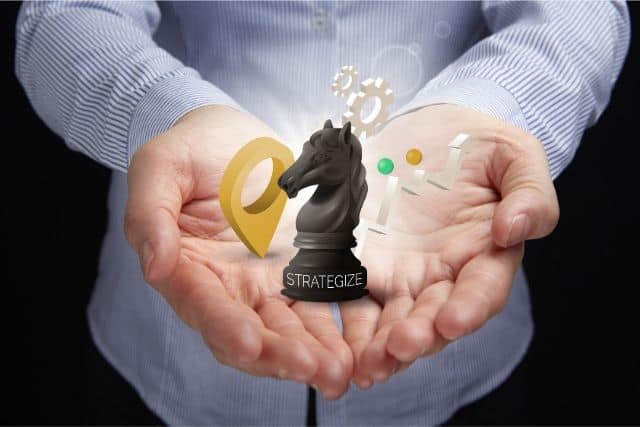The Strategic Role of Human Resource Managers
The strategic management process involves four important stages: environmental scanning, strategy formulation, strategy implementation, and evaluation and control.
What is Strategic Human Resource Management?
The strategic management process results in decisions that can have significant and long-lasting consequences. The erroneous strategic decision can inflict severe penalties can be exceedingly difficult, if not impossible, to reverse. Strategy evaluation, therefore, assumes greater relevance. Strategy evaluation helps determine the extent to which the company’s strategies are successful in attaining its objectives.
Why is Strategic Human Resource Management important?
Here are the benefits of strategic human resource management:
- It Increased job satisfaction.
- It Provides Better work culture.
- It Improved rates of customer satisfaction.
- Efficient resource management.
- A proactive approach to managing employees.
- It Boosts productivity.
Steps to Strategic Human Resource Management.
The strategic management process involves four important stages: environmental scanning, strategy formulation, strategy implementation, and evaluation and control.
1. Environmental Scanning
HR professionals play key roles in scanning the environment. More specifically HR can provide the following:
“From public information and legitimate recruiting and interview activities, you ought to be able to construct organization charts, staffing levels, and group missions for the various organizational components of each of your major competitors. Your knowledge of how brands are sorted among sales subdivisions and who reports to whom can give important clues as to a competitor’s strategic priorities. You may even know the track record and characteristic behavior of the executives”.
2. Strategy Formulation
Strategies are formulated at three levels:
1. Corporate level
2. Business unit level
3. Functional level
-
Corporate-level Strategy
This is formulated by the top management of an organization made up of more than one line of business. The corporate-level strategy of the family-controlled Siyaram Poddar Companies is to continuously innovate in all its businesses with the right technology, relentlessly cut costs and focus on the overseas markets. The major questions that need to be answered at this stage are- What kinds of business should the company be engaged in? What are the goats and expectations for each business? How should resources be allocated to reach these goals?
In formulating corporate-level strategies, the company should decide where it wants to be in 10 or 15 years hence in at least eight areas-market standing, innovation, productivity, physical and financial resources, profitability, managerial performance and development, worker performance, and attitudes, and social responsibility.
-
Business-level Strategy
While the major question at the corporate level is, “In what industries or businesses should we be operating?,” the appropriate question at the business unit level is, “How should we compete in the chosen industry or business?” A business unit is an organizational subsystem that has a market, a set of competitors, and a goal distinct from those of the other subsystems in the group. The concept of the strategic business unit (SBO) was pioneered by General Electric (GE). At GE, there are over 200 strategic business units, each having its own strategies consistent with the organization’s corporate-level strategy.
A single company that operates within one industry is also considered a business unit. For instance, an independent company that builds and sells swimming pools is considered a business unit. In such an organization, the corporate-level strategy and the business-unit strategy are the same.
-
Functional-level Strategy
Each business unit will consist of several departments, such as manufacturing, sales, finance, and HRD. Functional-level strategies identify the basic courses of action that each of the departments must pursue in order to help the business unit to attain its goals.
In formulating functional level strategies, managers must be aware that the different functions are interrelated. A change in one department will invariably affect the way other departments operate. Hence, the strategy of one functional area cannot be viewed in isolation. Rather, the extent to which all functional strategies are integrated determines the effectiveness of the unit’s business strategy.
What is the role of the HR executive in strategy formulation? He or she should evolve his or her own strategies which must be aligned with the corporate, unit, and functional strategies. Motorola is a vivid case. America-based MNC has been riding a roller coaster for two decades. Through the 1980s, the company’s market share was commanding. Profitability was excellent.
But in the early 1990s, the world of consumer electronics changed dramatically, as people began spending more and more time out of the office-working from homes, in planes, and in hotel rooms. They demanded faster, smaller, more integrated, and energy-efficient electronics. At the same time, competition for their business grew more and more intense. Major competitors sprang up in Europe and Asia, which produced more attractive and easy affordable products. The competition resulted in price cuts and heavy pressure on the bottom line of Motorola.
Working closely with line management, the HR professionals identified the culture that the increasingly competitive environment demanded. The HR team provided a powerful agenda for integrating staffing, performance management, training and development, structure, and communications with a common business focus and direction. This allowed HR to maximize its impact on performance. At the core of the HR strategy was understanding the organizational culture and integrating the former with business strategy.
Certain key steps in HR strategy formulation are worth recollecting in this context.
• Be clear whether the HR strategy is meant for corporate, unit, or functional level strategies. The decision is simple in as much as the same HR strategy shall be relevant for any level strategy.
• The next step is to identify the trends in the environment. Environmental scanning helps delineate the major trends.
• The third step is to have a SWOT analysis of the firm. Scanning the internal environment of the business helps list out its strengths and weaknesses and that of the external environment helps identify opportunities and threats.
• The fourth stage is the identification of key HR practices. Key HR practices fall into four basic categories.
The flow of People: Hiring, promotions, transfers, outplacement and training, and development
The flow of performance management: Measurement, rewards, and follow-up
The flow of information: Keeping the organization in touch with key external realities, managing internal communications, and designing information technology infrastructure.
The flow of work: Organization structure, work process design, and physical arrangements
3. Strategy Implementation
Strategies formulated need to be implemented. The implementation of strategies is often more difficult than its formulation. Implementing strategies require such actions as altering sales territories, adding new departments, closing facilities, hiring new employees, changing an organization’s pricing strategies, developing financial budgets, formulating new employee benefits, establishing cost-control procedures, changing advertising strategies, building new facilities, transferring managers among divisions and building a better computer information system.
Additionally, the HR function can contribute to strategic plans and actions of the firm in the following ways:
(A) Encouragement of Pro-active Rather than Reactive Behavior
Being pro-active means that the firm has a vision of where it wants to go 10 years hence, and has human resources who help it reach there.
(B) Explicit Communication of Goals
Generally, every firm shall have a goal and this must be communicated to all the employees. Everyone should work towards reaching the goal.
(C) Stimulation of Critical Thinking
Managers often depend on their personal views and experiences to solve problems and make decisions. The assumptions on which they make decisions can lead to success if they are appropriate to the environment in which the firm operates. However, serious problems can arise if the assumptions are no longer valid
(D) Productivity as an HR Based Strategy
The more productive an organization, the better is its competitive advantage. Perhaps none of the resources used for productivity in organizations are as critical as human resources. Many of the HR functions contribute to productivity. Pay, appraisal systems, training, selection, and job design are HR activities that directly contribute to productivity
(E) Quality and Service are HR-based Strategies
Besides productivity, other factors that contribute to a firm’s competitive advantage are quality and customer service. Quality can come from people, and realizing these firms are spending a vast sum of money on quality training
(F) Proficient Strategic Management
It depends heavily on competent personnel, better-than-adequate competent capabilities, and effective internal organization. Building a capable organization is obviously always a top priority in strategy execution.
4. Strategy Evaluation
The strategic management process results in decisions that can have significant and long-lasting consequences. The erroneous strategic decision can inflict severe penalties can be exceedingly difficult, if not impossible, to reverse. Strategy evaluation, therefore, assumes greater relevance. Strategy evaluation helps determine the extent to which the company’s strategies are successful in attaining its objectives. Basic activities involve in strategy evaluation are:
1. Establishing performance targets, standards, and tolerance limits for the objectives, strategies, and implementation plans.
2. Measuring the performance in relation to the targets at a given time. If outcomes are outside the limits, inform managers to take action.
3. Analyze deviations from acceptable tolerance limits.
4. Execute modifications where necessary and feasible.







